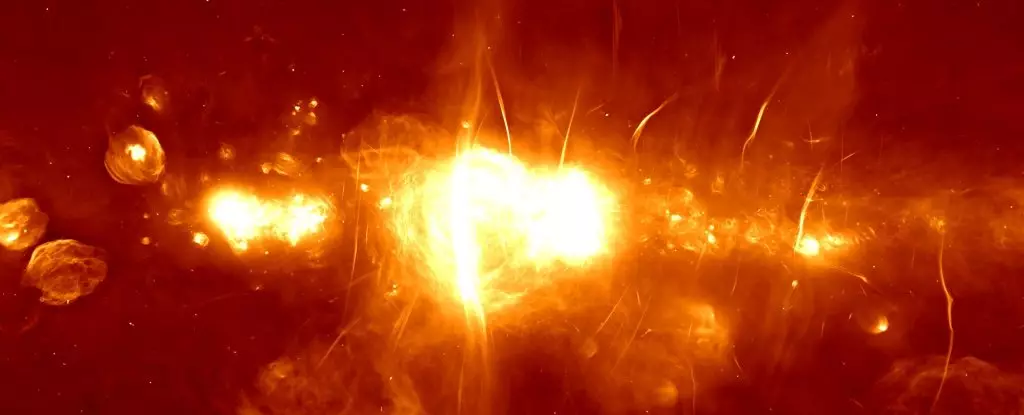The heart of the Milky Way is more chaotic and intricate than previously understood. New research led by astronomer Kai Yang from Shanghai Jiao Tong University has unveiled a groundbreaking discovery that challenges existing paradigms in astrophysics: the existence of slim filaments in the Central Molecular Zone (CMZ) surrounding our galaxy’s supermassive black hole. These structures are not merely optical illusions or minor variations of previously known filaments, but represent a unique cosmic phenomenon reminiscent of tornadoes, stirring the very fabric of interstellar matter in unprecedented ways.
The CMZ, measuring an impressive 2,000 light-years across, is a tumultuous region filled with dense clouds of gas and dust, which interacts violently with itself. It contains approximately 80 percent of the Milky Way’s dense gas and 5 percent of its total molecular gas. The chaos is palpable; as material moves at staggering speeds of up to 100 kilometers per second, clouds collide, coalesce, and disperse in a dance that has long confounded astronomers. This turbulent environment, rich in potential for star formation and galactic structure, is a wellspring of new phenomena awaiting discovery.
Deciphering the Slim Filaments
The research team employed the Atacama Large Millimeter/submillimeter Array (ALMA) in Chile to probe and analyze the CMZ in detail. Their primary objective was to identify traces of silicon monoxide, a molecule that plays a crucial role in defining shock waves—an essential aspect in understanding the CMZ’s dynamic behavior. The team made an unexpected and remarkable finding: long, slender filaments of silicon monoxide not previously observed. These newly identified structures, aptly named “slim filaments,” differ fundamentally from other known filamentary structures, raising many questions about their origins and functions.
The results revealed more than just the filaments’ unusual shapes. They were found to be rich in complex organic molecules like methanol, formaldehyde, and sulfur monoxide, and exhibited velocity distributions that challenge established understandings of galactic filament dynamics. These characteristics are indicative of a turbulent environment, suggesting that the slim filaments might play a similar role to that of the more familiar toroidal structures on Earth, such as tornadoes or dust devils. These cosmic structures appear to serve a vital function in the redistribution of materials throughout the galactic landscape.
The Dynamics of Formation
Although the mechanism of slim filament formation remains partially understood, the study posits that shock waves generated by violent collisions within the turbulent environment may be essential in their genesis. Such shocks could heat molecules into gas states, causing them to escape into the interstellar medium. As they cool, they condense back into dust, thus contributing to the recycling process in the CMZ.
Interestingly, this discovery indicates that slim filaments could represent a previously unrecognized class of structures, adding a new layer of complexity to our understanding of the CMZ’s gas dynamics. The findings suggest that these elongated filaments could significantly influence the recycling rate of materials in this star-forming region, heralding a new era in galactic dynamics. It is not an understatement to say that slim filaments could be pivotal in the broader cosmic cycle of material exchange, influencing star formation and galactic evolution at large.
Implications for Our Understanding of Galaxies
The implications of these findings extend far beyond the immediate environment of our galaxy. Understanding these slim filaments may provide crucial insights into similar processes occurring in other galactic systems. As astronomers delve deeper into the complex interplay of turbulence, shocks, and molecular interactions in various galaxies, the potential for discovering analogous structures elsewhere is tantalizing.
Moreover, this kind of research emphasizes the importance of advanced observational techniques like those provided by ALMA, which push the boundaries of our knowledge and reveal the unseen dynamics of the universe. The slim filaments redraft the picture of gas dynamics within galaxies, suggesting that much of the material displacement and interaction previously theorized may occur through mechanisms we had yet fully to comprehend.
In a rapidly advancing field where every discovery lays the groundwork for the next, the identification of slim filaments in the CMZ not only enriches our comprehension of galactic structures but also invites an exciting re-evaluation of cosmic dynamism. The more we uncover about our galaxy, the clearer it becomes: the universe is more complex and captivating than we can ever imagine.

